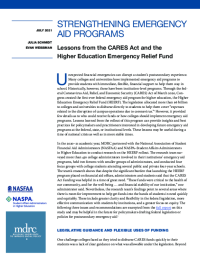Strengthening Emergency Aid Programs
Lessons from the CARES Act and the Higher Education Emergency Relief Fund

 Unexpected financial emergencies can disrupt a student’s postsecondary experience. Many colleges and universities have implemented emergency aid programs to provide students with immediate, flexible, financial support to help them stay in school. Historically, however, these have been institution-level programs. Through the federal Coronavirus Aid, Relief, and Economic Security (CARES) Act of March 2020, Congress created the first-ever federal emergency aid program for higher education, the Higher Education Emergency Relief Fund (HEERF). The legislation allocated more than $6 billion to colleges and universities to disburse directly to students to help them cover “expenses related to the disruption of campus operations due to coronavirus,” but provided few details as to who could receive funds or how colleges should implement emergency aid programs. Lessons from the rollout of this program can provide insights and best practices for policymakers and practitioners interested in developing future emergency aid programs at the federal, state, or institutional levels. These lessons may be useful during a time of national crisis as well as in more stable times.
Unexpected financial emergencies can disrupt a student’s postsecondary experience. Many colleges and universities have implemented emergency aid programs to provide students with immediate, flexible, financial support to help them stay in school. Historically, however, these have been institution-level programs. Through the federal Coronavirus Aid, Relief, and Economic Security (CARES) Act of March 2020, Congress created the first-ever federal emergency aid program for higher education, the Higher Education Emergency Relief Fund (HEERF). The legislation allocated more than $6 billion to colleges and universities to disburse directly to students to help them cover “expenses related to the disruption of campus operations due to coronavirus,” but provided few details as to who could receive funds or how colleges should implement emergency aid programs. Lessons from the rollout of this program can provide insights and best practices for policymakers and practitioners interested in developing future emergency aid programs at the federal, state, or institutional levels. These lessons may be useful during a time of national crisis as well as in more stable times.






